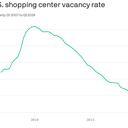Retail commercial real estate is so back

A good retail space is getting harder to find with the vacancy rate for shopping centers nationwide at a 15-year low.
Why it matters: The COVID-era doomsday predictions were wrong.
What they're saying: We haven't seen the apocalypse everyone was expecting, Thomas LaSalvia, head of commercial real estate economics at Moody's Analytics, tells Axios.
- Retail commercial real estate is "back for good," per a recent report from Cushman & Wakefield, a real estate services firm.
By the numbers: The vacancy rate at U.S. shopping centers — essentially any retail spaces outside the mall — fell to its lowest level since Cushman began tracking in 2007.
- Average asking rents in the sector were 4.1% higher in Q4 compared with a year earlier. They're up 17% cumulatively from 2019, and 41% over the past decade, per Cushman.
Zoom out: Demand for retail space stayed strong overall in 2023 thanks to a growing economy and strong labor market that kept Americans shopping. Retail sales were up 3.2% in 2023 from the previous year.
The big picture: The retail landscape is always evolving to adjust to changing tastes, spending habits and trends — from Main Street to shopping malls to big box and back again.
- The sector ran into a spate of store closings and bankruptcies as it faced web competition — and then COVID hit, leading to worries it would never recover.
- At the time landlords offered big concessions to some retail tenants to keep storefronts filled. Those deals are largely gone.
- That's meant depressed levels of retail construction for the past decade. "Lack of new retail construction has kept a ceiling on the vacancy rate since the start of the pandemic," per the Cushman report.
Context: Last year just 8 million square feet of new retail space was constructed — that's compared to about 20 million in 2019.
- Even those numbers are small compared to a decade ago. From 2008-2014, new construction averaged nearly 40.8 million square feet per year, per Cushman.
What's emerged is a more resilient retail landscape. These days e-commerce and physical retail now complement each other. Opening a brick-and-mortar store can even increase a brand's online sales, according to a study from late last year. Closing a store has the opposite effect.
- You might see something in a store, then head home to buy it online — or by something online while in a store, etc.
Meanwhile: Shopping centers have gotten more diverse — there are medical offices, gyms, day care centers, and pickleball.
- There's more flexibility to adapt to changing trends and tastes — the spaces themselves are more amenable to change, unlike say, a mall, that's more married to a large and hard-to-change footprint. (The mall landscape is still struggling to adjust to changing trends, particularly at the lower end.)
Between the lines: Retail's evolution may hold lessons for what's happening right now in the office real estate market, which is struggling to adapt to a more remote-friendly work world.
- Landlords might need to get flexible in what they do with all those empty offices, some of them might go away entirely or get converted to residential buildings or figure out some new mixed-use situation.
- "For office owners, it's very important that they make the adjustments necessary now," said LaSalvia.
- It took more than a decade for retail to adapt to a new era, it's reasonable to assume the office market will need a similar amount of time.